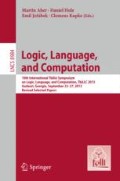Abstract
By Gentzen’s famous Hauptsatz (the cut-elimination theorem) every proof in sequent calculus for first-order logic with cuts can be transformed into a cut-free proof; cut-free proofs are analytic and consist entirely of syntactic material of the end-sequent (the proven theorem). But in systems with induction rules, cut-elimination is either impossible or does not produce proofs with the subformula property. One way to overcome this problem is to formulate induction proofs as infinite sequences of proofs in a uniform way and to develop a method, which yields a uniform description of the corresponding cut-free proofs. We present such a formalism, as an alternative to systems with induction rules, and define a corresponding cut-elimination method (based on the CERES-method for first-order logic). The basic tools of proof theory, such as sequent- and resolution calculi are enriched with inductive definitions and schemata of terms, formulas, proofs, etc. We define a class of inductive proofs which can be transformed into this formalism and subjected to schematic cut-elimination.
This work was supported by the project I383 of the Austrian Science Fund.
Access this chapter
Tax calculation will be finalised at checkout
Purchases are for personal use only
Notes
- 1.
General Architecture for Proof Theory framework, http://www.logic.at/gapt.
References
Aravantinos, V., Caferra, R., Peltier, N.: A schemata calculus for propositional logic. In: Giese, M., Waaler, A. (eds.) TABLEAUX 2009. LNCS (LNAI), vol. 5607, pp. 32–46. Springer, Heidelberg (2009)
Aravantinos, V., Caferra, R., Peltier, N.: Decidability and undecidability results for propositional schemata. J. Artif. Intell. Res. 40, 599–656 (2011)
Aravantinos, V., Echenim, M., Peltier, N.: A resolution calculus for first-order schemata. Fundamenta Informaticae 125(2), 101–133 (2013)
Baaz, M., Hetzl, S., Leitsch, A., Richter, C., Spohr, H.: Cut-elimination: experiments with CERES. In: Baader, F., Voronkov, A. (eds.) LPAR 2004. LNCS (LNAI), vol. 3452, pp. 481–495. Springer, Heidelberg (2005)
Baaz, M., Hetzl, S., Leitsch, A., Richter, C., Spohr, H.: CERES: an analysis of fürstenberg’s proof of the infinity of primes. Theoret. Comput. Sci. 403, 160–175 (2008)
Baaz, M., Leitsch, A.: Cut-elimination and redundancy-elimination by resolution. J. Symbolic Comput. 29(2), 149–176 (2000)
Baaz, M., Leitsch, A.: Towards a clausal analysis of cut-elimination. J. Symbolic Comput. 41(3–4), 381–410 (2006)
Brotherston, J.: Cyclic proofs for first-order logic with inductive definitions. In: Beckert, B. (ed.) TABLEAUX 2005. LNCS (LNAI), vol. 3702, pp. 78–92. Springer, Heidelberg (2005)
Brotherston, J., Simpson, A.: Sequent calculi for induction and infinite descent. J. Log. Comput. 21(6), 1177–1216 (2011)
Ciabattoni, A., Leitsch, A.: Towards an algorithmic construction of cut-elimination procedures. Math. Struct. Comput. Sci. 18, 81–105 (2008)
Dunchev, C.: Automation of Cut-Elimination in Proof Schemata. Ph.D. thesis, Vienna University of Technology (2012)
Dunchev, C., Leitsch, A., Rukhaia, M., Weller, D.: CERES for First-Order Schemata. Technical report, Vienna University of Technology (2012). http://arxiv.org/abs/1303.4257
Fontaine, P., Merz, S., Paleo, B.W.: Exploring and exploiting algebraic and graphical properties of resolution. In: SMT 2010. Edinburgh (2010)
Martin-Löf, P.: Hauptsatz for the Intuitionistic Theory of Iterated Inductive Definitions. In: Proceedings of the Second Scandinavian Logic Symposium, vol. 63 of Studies in Logic and the Foundations of Mathematics, pp. 179–216 (1971)
McDowell, R., Miller, D.: Cut-elimination for a logic with definitions and induction. Theoret. Comput. Sci. 232(1–2), 91–119 (2000)
Rukhaia, M.: CERES in Proof Schemata. Ph.D. thesis, Vienna University of Technology (2012)
Salzer, G.: On the Relationship between Cycle Unification and the Unification of Infinite Sets of Terms. In: Baader, F., Snyder, W. (eds.) UNIF 1993, Mass, Boston (1993)
Takeuti, G.: Proof Theory, 2nd edn. North Holland, Amsterdam (1987)
Author information
Authors and Affiliations
Corresponding author
Editor information
Editors and Affiliations
Rights and permissions
Copyright information
© 2015 Springer-Verlag Berlin Heidelberg
About this paper
Cite this paper
Dunchev, C., Leitsch, A., Rukhaia, M., Weller, D. (2015). Cut-Elimination and Proof Schemata. In: Aher, M., Hole, D., Jeřábek, E., Kupke, C. (eds) Logic, Language, and Computation. TbiLLC 2013. Lecture Notes in Computer Science(), vol 8984. Springer, Berlin, Heidelberg. https://doi.org/10.1007/978-3-662-46906-4_8
Download citation
DOI: https://doi.org/10.1007/978-3-662-46906-4_8
Published:
Publisher Name: Springer, Berlin, Heidelberg
Print ISBN: 978-3-662-46905-7
Online ISBN: 978-3-662-46906-4
eBook Packages: Computer ScienceComputer Science (R0)

